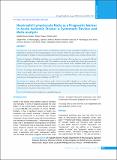Please use this identifier to cite or link to this item:
https://hdl.handle.net/20.500.14356/1454Full metadata record
| DC Field | Value | Language |
|---|---|---|
| dc.contributor.author | Paudel, Subodh Sharma | - |
| dc.contributor.author | Thapa, Bikram | - |
| dc.contributor.author | Luitel, Ritesh | - |
| dc.date.accessioned | 2023-05-14T05:56:21Z | - |
| dc.date.available | 2023-05-14T05:56:21Z | - |
| dc.date.issued | 2020 | - |
| dc.identifier.citation | PaudelS. S., ThapaB., & LuitelR. (2021). Neutrophil Lymphocyte Ratio as a Prognostic Marker in Acute Ischemic Stroke: a Systematic Review and Meta-analysis. Journal of Nepal Health Research Council, 18(4), 573-579. https://doi.org/10.33314/jnhrc.v18i4.3143 | en_US |
| dc.identifier.issn | Print ISSN: 1727-5482; Online ISSN: 1999-6217 | - |
| dc.identifier.uri | http://103.69.126.140:8080/handle/20.500.14356/1454 | - |
| dc.description | Review Article | en_US |
| dc.description.abstract | Abstract Background: Acute ischemic stroke leads to an inflammatory response and the neutrophil-to-lymphocyte ratio is an inflammatory indicator for determining prognosis in acute ischemic stroke. This meta-analysis aims to show evidence that neutrophil-to-lymphocyte can act as an independent and early prognostic marker in cases of acute ischemic stroke. Methods: Databases of PubMed, and Embase were searched for literature. Relevant data were extracted by SSP and BT from eligible literature. Odds ratios with 95% confidence intervals were pooled and a Forest plot was used to evaluate the prognostic value of neutrophil-to-lymphocyte in acute ischemic stroke. Modified Rankin Scale ? 3 was defined as a poor functional outcome. A funnel plot is used to show the symmetric distribution and no publication bias. Results: According to Joanna Briggs Institute assessment for analytical observational studies, the studies included are of fair to good quality. Eight relevant studies with 3011 patients were included, one with no data on OR. The pooled OR of 6 studies with the poor functional outcome at 3 months was 1.47(P<0.02 95%CI: 1.40-2.31) while one study with the poor functional outcome at discharge was OR=2.49. Conclusions: In patients with acute ischemic stroke, elevated neutrophil-to-lymphocyte correlates with poorer functional outcome and increased chances of developing symptomatic Intracranial Hemorrhage. Baseline neutrophil-to-lymphocyte can be an inexpensive and easily available biomarker, especially in resource-poor settings, for predicting clinical outcomes in patients with ischemic stroke. Keywords: Ischemic stroke; lymphocyte; neutrophil; prognosis. | en_US |
| dc.language.iso | en | en_US |
| dc.publisher | Nepal Health Research Council | en_US |
| dc.relation.ispartofseries | Oct-Dec, 2020;3143 | - |
| dc.subject | Ischemic stroke | en_US |
| dc.subject | Lymphocyte | en_US |
| dc.subject | Neutrophil | en_US |
| dc.subject | Prognosis | en_US |
| dc.title | Neutrophil Lymphocyte Ratio as a Prognostic Marker in Acute Ischemic Stroke: a Systematic Review and Meta-analysis | en_US |
| dc.type | Journal Article | en_US |
| local.journal.category | Review Article | - |
| Appears in Collections: | Vol. 18 No. 4 (2020): Vol. 18 No. 4 Issue 49 Oct-Dec 2020 | |
Files in This Item:
| File | Description | Size | Format | |
|---|---|---|---|---|
| 3143-Manuscript-19982-1-10-20210122.pdf | Fulltext Download | 514.61 kB | Adobe PDF |  View/Open |
Items in DSpace are protected by copyright, with all rights reserved, unless otherwise indicated.
